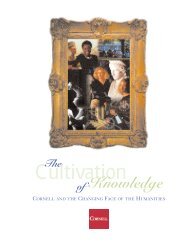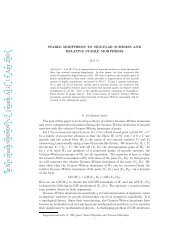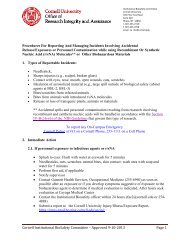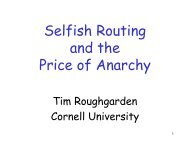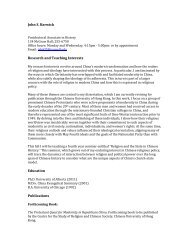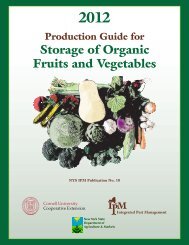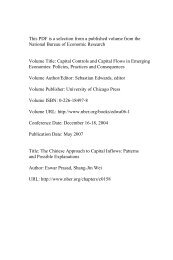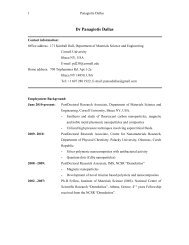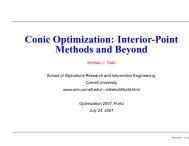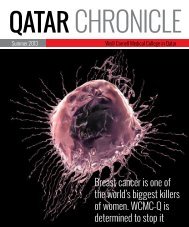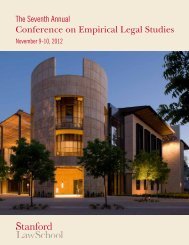Unlocking Genetic Secrets of the Date Palm - Weill Cornell Medical ...
Unlocking Genetic Secrets of the Date Palm - Weill Cornell Medical ...
Unlocking Genetic Secrets of the Date Palm - Weill Cornell Medical ...
You also want an ePaper? Increase the reach of your titles
YUMPU automatically turns print PDFs into web optimized ePapers that Google loves.
Highlights <strong>of</strong> this issue122The Story <strong>of</strong> <strong>the</strong> Human CellNobel Prize winner Günter Blobel MD,PhD, discusses his research on cellmechanisms at <strong>the</strong> fourth Qatar FoundationDistinguished Lecture Series at WCMC-Q.4Transforming <strong>the</strong> Research LandscapeBiomedical research at WCMC-Qsupported by Qatar Foundation plays acrucial role in <strong>the</strong> renaissance <strong>of</strong> sciencetaking place in <strong>the</strong> country and <strong>the</strong> region.12Researchers Unlock <strong>Genetic</strong> <strong>Secrets</strong><strong>of</strong> <strong>the</strong> <strong>Date</strong> <strong>Palm</strong>Joel Malek, PhD, director <strong>of</strong> <strong>the</strong> genomicslab, and his research assistants unlock<strong>the</strong> genetic secrets <strong>of</strong> <strong>the</strong> date palm andvalidate <strong>the</strong> use <strong>of</strong> sophisticated genomicstechnology in <strong>the</strong> Gulf Region.1414Ano<strong>the</strong>r Great MatchMembers <strong>of</strong> <strong>the</strong> Class <strong>of</strong> 2009 celebrate <strong>the</strong>irmatches with residency programs in <strong>the</strong> USand Qatar as <strong>the</strong>y move on to <strong>the</strong> next phase<strong>of</strong> <strong>the</strong>ir medical and scientific careers.17Sustainable Development in QatarRenee Richer, PhD, assistant pr<strong>of</strong>essor <strong>of</strong> biology, promotes strategies for sustainabledevelopment in Qatar’s Second National Human Development report.<strong>Weill</strong> <strong>Cornell</strong> <strong>Medical</strong> College in Qatar was jointly established by<strong>the</strong> Qatar Foundation for Education, Science and Community Developmentand <strong>Cornell</strong> UniversitySpring 2009 1
News from WCMC-QA Story <strong>of</strong> <strong>the</strong> Human CellFourth Qatar Foundation Distinguished Lecture Series held at WCMC-QGünter Blobel discusses his research on <strong>the</strong> signals that govern <strong>the</strong> transport and localization <strong>of</strong> proteins in <strong>the</strong> cell.Audience members from <strong>Weill</strong><strong>Cornell</strong> <strong>Medical</strong> College inQatar and beyond filled one<strong>of</strong> <strong>the</strong> campus lecture halls on March17 th to listen to world renowned scientistGünter Blobel explain cellmechanisms that have set <strong>the</strong> stagefor research in <strong>the</strong> coming decades.Blobel, winner <strong>of</strong> <strong>the</strong> 1999 NobelPrize for Medicine for his work in uncovering<strong>the</strong>se mechanisms, spoke at<strong>the</strong> fourth Qatar Foundation DistinguishedLecture Series at WCMC-Q.He chose to avoid complete focuson what might fall under <strong>the</strong> lecture’stitle: “Access to <strong>the</strong> Nucleus,<strong>the</strong> Innermost Sanctuary <strong>of</strong> <strong>the</strong> Cell,”and broke <strong>the</strong> topic into several sections.He said he wanted studentsto be inspired about “how little weknow” more than he intended to godeeply into his findings for <strong>the</strong> seasonedresearchers in <strong>the</strong> audience.“As you sit here in this room, froma cellular point <strong>of</strong> view, you are fourbillion years old. A continuous fourbillion years <strong>of</strong> cell division, and cellevolution — this is something thatis absolutely magnificent … and wedon’t really realize how old we are,”Blobel explained.The audience gained a sense <strong>of</strong>how <strong>the</strong> cell evolved over time andhow all <strong>of</strong> its parts, as <strong>the</strong>y developed,have been replicated over <strong>the</strong>years in all living organisms. Untilabout 50 years ago, with <strong>the</strong> dawn <strong>of</strong><strong>the</strong> electron microscope, all scientistscould do was speculate about what<strong>the</strong> big black dot and o<strong>the</strong>r tiny dotsin <strong>the</strong> cells were — <strong>the</strong>n, <strong>the</strong> revolutionin cell biology took place.“And over <strong>the</strong> next 20 years peopledescribed everything you could possiblyfind in a cell. But what wasn’treally clear was how things talkedto each o<strong>the</strong>r,” he said. “We made avery bold hypo<strong>the</strong>sis and <strong>the</strong>re wasabsolutely zero evidence.”Blobel was a pioneer in a researchfield now known as intracellular proteintraffic, and would eventually win<strong>the</strong> Nobel Prize for discovering thatproteins have intrinsic signals thatgovern <strong>the</strong>ir transport and localizationin <strong>the</strong> cell.“Specific sequence elements inproteins are like a zip code to directproteins to a cellular address, and if<strong>the</strong> protein does not arrive at <strong>the</strong> cellu-2 Qatar Chronicle
News from WCMC-Q“As you sit here in this room, from a cellular point <strong>of</strong> view, you are four billion years old.A continuous four billion years <strong>of</strong> cell division, and cell evolution — this is something thatis absolutely magnificent … and we don’t really realize how old we are.”— Günter Blobellar address, it cannot function. It’s verymuch like a love letter that isn’t sent to<strong>the</strong> right address … well, if it isn’t sentto <strong>the</strong> right address it may have an adversereaction,” he explained.To inspire <strong>the</strong> students and youngresearchers in <strong>the</strong> audience, Blobeldescribed a phase in his researchwhere he challenged <strong>the</strong> idea thation regulation around membraneswould not possibly allow his hypo<strong>the</strong>sizedprotein conducting channel.Everyone around him expresseddoubt, including his funders, whowithdrew grants. Luckily, RockefellerUniversity in <strong>the</strong> United Statesfound his work interesting and investedin him.“So, you must not give up if youreally think you have a good idea. Iwish I could tell you <strong>the</strong> excitementas we detected <strong>the</strong> protein conductingchannel by electrophysiology,” hesaid gleefully.Although he spent 40 yearsworking to open many doors forupcoming researchers, Blobel saidhe wished he had 40 more years towalk through those doors himself.It’s an exciting time in a line <strong>of</strong>work that has no end.“Human knowledge will be imperfectforever … but is indefinitelyperfectable,” he said quoting an acquaintance.“I think this indefiniteperfectability is what drives us, whatinspires us and is <strong>the</strong> inspiration thatI wanted to transmit to you.”—Emily AlpSpring 2009 3
News from WCMC-QBuilding a Research CultureStem Cell Work, Science Park Transform LandscapePr<strong>of</strong>essor Sir Martin Evans, 2007 Nobel Laureate in Medicine, left, and Dr. Javaid Sheikh at <strong>the</strong> Qatar Stem Cell Workshop on Science & Policy.With Nobel Laureatesas speakers and participationby scientists,diplomats, physicians and studentsfrom around <strong>the</strong> globe, <strong>Weill</strong> <strong>Cornell</strong><strong>Medical</strong> College in Qatar and QatarFoundation hosted <strong>the</strong> Gulf state’sfirst international conference on stemcell science and policy.The topic is an important onefor <strong>the</strong> entire medical and scientificcommunity and for <strong>the</strong> ambitiousbiomedical research program spearheadedby WCMC-Q and QatarFoundation.“Stem cell research is an integralpart <strong>of</strong> our new genetic and molecularresearch program,” said Dr. JavaidSheikh, MD, interim dean, who servedas one <strong>of</strong> <strong>the</strong> moderators <strong>of</strong> <strong>the</strong> Marchconference. “Our study <strong>of</strong> stem cellsand <strong>the</strong>ir use in <strong>the</strong>rapies and treatmentswill help us improve <strong>the</strong> health<strong>of</strong> Qataris and o<strong>the</strong>rs around <strong>the</strong> world.This forum and our research demonstrateclearly that <strong>the</strong>re is a renaissancein science taking place in Qatar.”Stem cell research is already underwayat WCMC-Q in <strong>the</strong> laboratory<strong>of</strong> Arash Rafii Tabrizi, MD, PhD, assistantpr<strong>of</strong>essor <strong>of</strong> genetic medicinein obstetrics and gynecology. He isworking with embryonic stem celllines from <strong>the</strong> Ansary Stem Cell Centerfor Regenerative Medicine at <strong>Weill</strong><strong>Cornell</strong> <strong>Medical</strong> College in New York.WCMC-Q Stem Cell Research“We have four different cell linesand <strong>the</strong>y are growing well. As we develop<strong>the</strong>se cells into hematopoetic orblood forming cells, we want to study<strong>the</strong>ir attraction with <strong>the</strong> endo<strong>the</strong>lium,<strong>the</strong> layer <strong>of</strong> cells that line <strong>the</strong> interiorsurface <strong>of</strong> blood vessels. Our goal is tolearn how <strong>the</strong> stem cells interact andisolate <strong>the</strong> chemical signals that trigger<strong>the</strong>ir expansion and differentiation.”Dr. Rafii Tabrizi also is workingwith ovarian and breast cancer cellsto understand how cancer cells acquirechemoresistance.For Fayez Safadi, PhD, adjunctassistant pr<strong>of</strong>essor <strong>of</strong> cell and developmentalbiology at WCMC-Q, stemcells may ultimately be harnessed tohelp build new bone for those sufferingfrom osteoporosis and arthritisand o<strong>the</strong>r musculoskeletal disorders.Safadi recently received a five-year,$1.25 million grant from <strong>the</strong> NationalInstitutes <strong>of</strong> Health in <strong>the</strong> UnitedStates to continue his research on <strong>the</strong>regulatory mechanisms <strong>of</strong> bone celldevelopment, differentiation andfunction in normal and diseased boneand cartilage. Several years ago, hediscovered a gene named osteoactivinthat appears to activate bone growth.While he continues to study <strong>the</strong> geneand its role in osteoblast differentiationand bone formation, he plans to workwith stem cells and try to harness <strong>the</strong>irability to differentiate into bone cellsand promote bone growth.Making <strong>the</strong> ConnectionsTo ensure that WCMC-Q’s stem cellresearch is connected firmly to internationalscience and health policy, QatarFoundation formed a partnership with4 Qatar Chronicle
News from WCMC-Q<strong>the</strong> James Baker III Institute forPublic Policy at Rice Universityin <strong>the</strong> US. Toge<strong>the</strong>r withWCMC-Q, <strong>the</strong>y sponsored<strong>the</strong> international stem cellconference as part <strong>of</strong> <strong>the</strong> effortto bring toge<strong>the</strong>r key researchers,ethicists, policymakers,and business leaders.“The partnership helpsbridge <strong>the</strong> gap between <strong>the</strong>oryand practice and createsan international dialog that isessential for advancing scientificresearch,” said Edward P.Djerejian, a founding director<strong>of</strong> <strong>the</strong> James Baker Institutefor Public Policy and a formerUS diplomat familiar with <strong>the</strong>Middle East.Besides an overview <strong>of</strong>current research on stem cellsby Nobel Laureate Sir MartinEvans, director <strong>of</strong> <strong>the</strong> School<strong>of</strong> Biosciences and pr<strong>of</strong>essor<strong>of</strong> mammalian genetics, CardiffUniversity, and GünterBlobel, director <strong>of</strong> <strong>the</strong> Laboratory<strong>of</strong> Cell Biology atRockefeller University in <strong>the</strong>US, conference participantsdiscussed opportunities forfuture research and <strong>the</strong> moral,ethical and cultural implications<strong>of</strong> stem cell research.Ano<strong>the</strong>r Research MilestoneThe stem cell workshop coincidedwith ano<strong>the</strong>r major milestone in <strong>the</strong>development <strong>of</strong> Qatar’s research infrastructure— <strong>the</strong> opening <strong>of</strong> QatarScience and Technology Park adjacentto Education City. The 11-acre,$800 million site, provides a platformfor academicians, researchers, andindustry to develop and commercializenew technologies emanating from<strong>the</strong> research programs at <strong>the</strong> nearbyuniversities and o<strong>the</strong>rs around <strong>the</strong>world. (See story on page 10.)“The leadership by <strong>the</strong> governmentSpeakers at <strong>the</strong> Qatar Stem Cell Workshop on Science & Policy, clockwise from top left: StephenMinger, King’s College London; Fathy Saoud, Qatar Foundation; Irving Weissman, Stanford Institutefor Stem Cell Biology and Regenerative Medicine; and Margaret Elizabeth Ross, <strong>Weill</strong> <strong>Cornell</strong><strong>Medical</strong> College.<strong>of</strong> Qatar is visionary,” said KhaledMachaca, PhD, associate dean for basicscience research at WCMC-Q andpr<strong>of</strong>essor <strong>of</strong> physiology and biophysics.“Education City demonstrates itscommitment to building a world-classeducational and research infrastructure.With QSTP, <strong>the</strong> governmentprovides a forum for <strong>the</strong> applicationand commercialization <strong>of</strong> research.“We are a small country, whichmakes it possible for everyone to worktoge<strong>the</strong>r and to make powerful connections,”said Machaca, who is workingclosely with Dr. Sheikh to implementWCMC-Q’s research program andwith Qatar Foundation to build a vibrantbiomedical research communityand a world-class research program.“Qatar’s commitment to research,education, science and technology isdemonstrated by <strong>the</strong> dedication <strong>of</strong>2.8 percent <strong>of</strong> its gross national productto research programs,” said FathySaoud, PhD, president <strong>of</strong> Qatar Foundation.“We are creating a researchlandscape that consists <strong>of</strong> both basicand applied research with our universitypartners, with industry andwith centers <strong>of</strong> excellence around <strong>the</strong>world. We are opening our doors, ourhands and our hearts to internationalcollaboration.”—Kristina GoodnoughSpring 2009 5
WCMC-Q Student Authors Published in New CollectionAnew book, Qira’at: Readingsfrom <strong>the</strong> Students <strong>of</strong> <strong>Weill</strong> <strong>Cornell</strong><strong>Medical</strong> College in Qatar,2004-2008 compiles <strong>the</strong> best essays bystudents from <strong>the</strong> last four years.The essays were selected by competition.Of more than 40 submissions,27 were selected for publication, andprizes awarded to <strong>the</strong> top three.WCMC-Q writing faculty chose10 finalists, and writing faculty from<strong>Cornell</strong> University in Ithaca determined<strong>the</strong> winners.“Rieux: A Willing Victim <strong>of</strong> Abstraction”by Tasnim Khalife took firstplace for being, in <strong>the</strong> judges’ words,“<strong>the</strong> most nuanced and elegant <strong>of</strong> <strong>the</strong>ten semifinalist essays” and “an exemplarywork <strong>of</strong> literary criticism.”“Gulf Research: Stem Cell Research”by Marwa Saleh took secondplace, while third place went toAnayah Sarkar for “Adolescent Ethics,”an essay based on actual eventsfrom her clinical training.“The Psychoanalytical Theory: IsWCMC-Q student authors at <strong>the</strong> ceremony celebrating <strong>the</strong> release <strong>of</strong> Qira’at, ananthology <strong>of</strong> <strong>the</strong>ir essays.it relevant today?” by Samarpit Raireceived Honorable Mention — acategory specifically created by <strong>the</strong>judges to recognize <strong>the</strong> high quality<strong>of</strong> his work.“This process provides valuableadvanced training for writing futurescientific research papers, presentations,and notes in pr<strong>of</strong>essionalnewsletters,” said Alan Weber, PhD,assistant pr<strong>of</strong>essor <strong>of</strong> writing anddriving force behind <strong>the</strong> book.A reading and award ceremony washeld to celebrate <strong>the</strong> release <strong>of</strong> <strong>the</strong> anthologyand honor <strong>the</strong> contest winners.Qira’at is now available for purchase by<strong>the</strong> general public at select Doha bookstores.Pr<strong>of</strong>its from <strong>the</strong> sales <strong>of</strong> Qira’atwill go to <strong>the</strong> Qatar National CancerSociety, an organization that campaignsto raise awareness <strong>of</strong> and funds for cancereducation and research.A New Tradition On The BooksMay this gift <strong>of</strong> a textbookabout <strong>the</strong> beginnings <strong>of</strong> humanlife inspire and teachyou in our shared discipline<strong>of</strong> medicine.These words, inscribedby authorRebecca Baergen,MD in <strong>the</strong> front pages <strong>of</strong>her book helped inauguratea new tradition,<strong>the</strong> Faculty Textbook &Monograph Collectionin <strong>the</strong> Distributed eLibraryReading Room.To build <strong>the</strong> new collection, residentand visiting faculty are invitedto donate copies <strong>of</strong> books <strong>the</strong>y haveauthored or edited, or in which6 Qatar ChronicleRebecca Baergen signs a copy <strong>of</strong> her textbook for <strong>the</strong> collection in <strong>the</strong>Distributed eLibrary Reading Room.<strong>the</strong>y have authored a chapter. Thesection will also contain books detailing<strong>the</strong> history <strong>of</strong> WCMC-Q.The collection was <strong>the</strong> brainchild<strong>of</strong> Powers Peterson, MD, acting as-sociate dean for basicscience curriculum, with<strong>the</strong> cooperation <strong>of</strong> <strong>the</strong>DeLib staff. Her intent isto inspire students with<strong>the</strong> literary and academicachievements <strong>of</strong><strong>the</strong>ir instructors, to helpthose faculty memberslead by example.“We want students tosee <strong>the</strong> names <strong>of</strong> peoplewhose educational activitiesinclude writing— physicians and scientists<strong>the</strong>y actually know and who havecontributed to <strong>the</strong>ir education here.”Baergen, pr<strong>of</strong>essor <strong>of</strong> clinical pathologyand laboratory medicine atWCMC in New York, donated a copy
Shaping Medicine’s Future LeadersWhen you hear <strong>the</strong> word“leader,” you may think <strong>of</strong>a head <strong>of</strong> state stirring up<strong>the</strong> masses with a campaign promiseor speech. You may also think “not me,I hate <strong>the</strong> spotlight.” This past January,pre-medical students at WCMC-Qsigned a contract to discover <strong>the</strong> leaderwithin <strong>the</strong>mselves. The activities <strong>the</strong>ysigned up for — all part <strong>of</strong> a six-dayLeadershape workshop — had little todo with speech giving or rally cries.“Leadership doesn’t mean you’re infront. You can lead in your own way.Some may take over at some point butthat doesn’t mean <strong>the</strong>y’re <strong>the</strong> leader, itjust means <strong>the</strong>y’re <strong>the</strong> loudest,” saidEric Fry, director <strong>of</strong> student affairs atWCMC-Q and cluster facilitator forthis year’s Leadershape workshop.Selected by essay applications,17 WCMC-Q students joined o<strong>the</strong>rsfrom universities throughout EducationCity for <strong>the</strong> workshop, whichtook place at Al Khor beach resort.They were not allowed to bring laptops,and text messaging time wasstrictly limited to breaks.The participants were randomlydivided into clusters — teams <strong>of</strong> 10that worked toge<strong>the</strong>r and encouragedone ano<strong>the</strong>r through <strong>the</strong> rest <strong>of</strong><strong>the</strong> workshop. For most students, Frysaid, being a part <strong>of</strong> <strong>the</strong> family groupwas <strong>the</strong> highlight <strong>of</strong> <strong>the</strong> workshop asit allowed <strong>the</strong>m to do a lot <strong>of</strong> interpersonalwork.“It’s like magic, what we felt <strong>the</strong>re.So when I feel worn out from workLeadershape participants take a break from activities. Clockwise from left: Mohsen Ahmed;Eric Fry, director <strong>of</strong> Student Affairs; Afaf Osman; Mais Al-Kawaz, Zaid Hague, Tarek Elshazly,Abdulhadi Al Saei, Haneen A. Mohamhd, Rama AlBuz, R<strong>of</strong>yda Marmar; Nour Barakat;Deena Wafadari; Abeer Al Majali; Arunima Bera; and Sundus Sardar.and stress, I look through <strong>the</strong> Leadershapeprogram binder and it makesme feel happy again because we hadlots <strong>of</strong> good memories <strong>the</strong>re,” saidHaneen Mohamhd.Each day, students explored<strong>the</strong>mes such as community, identity,and power. Related activities helped<strong>the</strong>m develop a deeper sense <strong>of</strong> whatit means to be a leader.“The lessons are stuck in my mind,because it wasn’t lectures. It was‘learn by doing,’” said Abdulhadi AlSaei, Leadershape participant andWCMC-Q student.For WCMC-Q students in particular,Leadershape gave <strong>the</strong>m <strong>the</strong> chanceto see <strong>the</strong>mselves as leaders in <strong>the</strong> field<strong>of</strong> medicine. “It’s actually a life-definingexperience because it teaches younothing is impossible. You can haveyour goals and dreams and know howto achieve <strong>the</strong>m,” Mohamhd said.Perhaps <strong>the</strong> most important lesson<strong>of</strong> all for <strong>the</strong> students was that leadershipinvolves both those who seem t<strong>of</strong>ollow and those who seem to lead. Aself-assessment test helped studentsuncover <strong>the</strong>ir own leadership typeand <strong>the</strong> related strengths and challenges.Nour Barakat, Leadershapeparticipant and WCMC-Q student,discovered that she has a tendency tobe dominant and learned that <strong>the</strong>reare ways to manage <strong>the</strong> trait to be amore effective leader.“I learned that when I sit and listento o<strong>the</strong>rs’ opinions, it gives a betterresult in <strong>the</strong> end,” she said.—Emily AlpA New Tradition On The Books (continued from page 6)<strong>of</strong> her textbook, Manual <strong>of</strong> Benirschkeand Kaufmann’s Pathology <strong>of</strong> <strong>the</strong> HumanPlacenta while at WCMC-Q asvisiting faculty in <strong>the</strong> Basis <strong>of</strong> Diseasecourse. A book signing was heldin <strong>the</strong> Reading Room to celebrate <strong>the</strong>launch <strong>of</strong> <strong>the</strong> collection.O<strong>the</strong>r contributing visiting facultymembers include WCMCclinical pr<strong>of</strong>essor <strong>of</strong> medicine PaulMiskovitz, MD; and <strong>Cornell</strong> Universitypsychology pr<strong>of</strong>essor James B.Maas, MD, PhD.WCMC-Q faculty members whohave also contributed to <strong>the</strong> collectioninclude pr<strong>of</strong>essor <strong>of</strong> pediatrics and <strong>of</strong>genetic medicine Ahmad Teebi, MB-BCh, senior lecturer in writing PeterFortunato, MFA, and associate deanfor premedical education MichaelJohnson, PhD.Spring 2009 7
Fall Highlight: <strong>the</strong> Student Research ForumWeeks <strong>of</strong> research culminate in oral and poster presentations during <strong>the</strong> <strong>Medical</strong> Student Research Forum.Student research took <strong>the</strong> spotlight at <strong>the</strong> fifthAnnual <strong>Medical</strong> Student Research Forum onNovember 11, where WCMC-Q medical studentsonce again demonstrated <strong>the</strong>ir expertise inresearch activities.In a series <strong>of</strong> oral and poster presentations, <strong>the</strong> studentsdiscussed <strong>the</strong>ir summer research projects investigatingsuch areas as <strong>the</strong> causes <strong>of</strong> Alzheimer’s disease, how tumorsresist radiation <strong>the</strong>rapy, whe<strong>the</strong>r certain proteinsinhibit <strong>the</strong> spread <strong>of</strong> breast cancer cells, and more.The research forum remains a highlight <strong>of</strong> <strong>the</strong> fall semester.This year, prizes were awarded for <strong>the</strong> first time to<strong>the</strong> top two presenters in each category.A total <strong>of</strong> 30 WCMC-Q students competed for andwere awarded summer research fellowships in 2008,compared to 20 students <strong>the</strong> previous year.The majority <strong>of</strong> <strong>the</strong> awardees traveled to <strong>the</strong> US towork with leading researchers in <strong>the</strong> labs <strong>of</strong> WCMC inNew York and <strong>Cornell</strong> University in Ithaca. A handful<strong>of</strong> <strong>the</strong> students performed <strong>the</strong>ir research at WCMC-Q,taking advantage <strong>of</strong> its developing facilities and <strong>the</strong> expertise<strong>of</strong> <strong>the</strong> resident faculty.Mohammed Hamza Shah and Mouayyad Zaza bothchose to do <strong>the</strong>ir summer research locally in Qatar. Theirproject in <strong>the</strong> laboratory <strong>of</strong> Khaled Machaca, PhD, associatedean for basic science research, aims to betterunderstand how calcium is regulated during oocytematuration, which could have practical uses in in vitr<strong>of</strong>ertilization and <strong>the</strong> treatment <strong>of</strong> female infertility.Machaca believes <strong>the</strong> critical thinking and problemsolving skills students get from research projects broaden<strong>the</strong>ir perspective, ultimately helping <strong>the</strong>m become better2008 <strong>Medical</strong> Student Research Forum Presentation WinnersOral PresentationsFarah Ali SiamExploring <strong>the</strong> Functionality <strong>of</strong> a Meiosis-Specific Cre inTransgenic MiceFaculty Sponsor: Dr. Paula Cohen, Veterinary ResearchTower – <strong>Cornell</strong> UniversityMohamed Al-KazazNew Therapeutic Approach to Alzheimer’s Disease: Blocking<strong>the</strong> Amyloidgenic Pathway Using <strong>the</strong> Catalytic Site if Pin1Faculty Sponsor: Dr. Linda Nicholson, associate pr<strong>of</strong>essor<strong>of</strong> molecular biology and genetics, <strong>Cornell</strong>UniversityPoster PresentationsKarima Becetti and Sumeja ZahirovicDiabetes SNPs in QatarFaculty Sponsor: Dr. Ronald Crystal, chairman <strong>of</strong><strong>the</strong> Department <strong>of</strong> <strong>Genetic</strong> Medicine, <strong>Weill</strong> <strong>Cornell</strong><strong>Medical</strong> CollegeShady NakhlaEffects <strong>of</strong> VEGF on placental morphology and overall fetalhealth in a mouse model <strong>of</strong> pre-eclampsia, BPH/5Faculty Sponsor: Dr. Robin Davisson, pr<strong>of</strong>essor <strong>of</strong> celland developmental biology at <strong>Weill</strong> <strong>Cornell</strong> <strong>Medical</strong>College and pr<strong>of</strong>essor <strong>of</strong> molecular physiology at <strong>Cornell</strong>University College <strong>of</strong> Veterinary Medicine8 Qatar Chronicle
Farah Siam, left. and Mohamed Al-Kazaz, members <strong>of</strong> <strong>the</strong> class <strong>of</strong> 2012, discuss <strong>the</strong>ir research projects at <strong>the</strong> research forum.physicians. “It improves <strong>the</strong>ir understanding <strong>of</strong> <strong>the</strong> verybasic science that underlies all <strong>of</strong> medicine,” he said.Dr. Javaid Sheikh, interim dean and vice dean for research,described <strong>the</strong> Research Forum as “one facet <strong>of</strong>WCMC-Q’s overall strategy to build a biomedical researchculture and infrastructure in Qatar.”WCMC-Q’s research program, developed in partnershipwith Qatar Foundation, aims to create a biomedicalresearch infrastructure in Qatar and a scientific and technicalworkforce for <strong>the</strong> benefit <strong>of</strong> <strong>the</strong> region at large. Incooperation with partners in <strong>the</strong> region, <strong>the</strong> programsupports high quality research in <strong>the</strong> fields <strong>of</strong> geneticand molecular medicine, women’s and children’s health,gene <strong>the</strong>rapy, stem cells, and vaccine development.Premed Researchers Head to Labs in BelfastUndergraduate researchers at <strong>Weill</strong> <strong>Cornell</strong><strong>Medical</strong> College in Qatar have been awardedjust over £16,000 — more than $24,000 — from<strong>the</strong> United Kingdom. The money, in <strong>the</strong> form <strong>of</strong> aPrime Minister’s Initiative for International Education(PMI2) grant, will fund <strong>the</strong> travel to and accommodationsin Belfast, Ireland, for premedical students, whowill conduct research that will <strong>of</strong>fer a bigger picture <strong>of</strong><strong>the</strong> work <strong>the</strong>y’ve been doing.Students will travel over <strong>the</strong> two years that <strong>the</strong> grantis distributed, and pre-medical student Mason Al Nouriwill be <strong>the</strong> first to go. Al Nouri is working on a projectunder <strong>the</strong> guidance <strong>of</strong> Michael Pungente, PhD, chemistrypr<strong>of</strong>essor and researcher at WCMC-Q.“Traveling to labs abroad helps enrich <strong>the</strong> students’perception toward research by giving <strong>the</strong>m a breadth<strong>of</strong> practical research experience,” Pungente said. “It’sfunding opportunities like PMI2 that really allow thisexchange <strong>of</strong> vital information to flow.”Pungente collaborates directly with WilliamGoldring, PhD, an organic chemistry pr<strong>of</strong>essor andresearcher at Queen’s University in Belfast. They areworking on a project to syn<strong>the</strong>size and characterizenovel compounds used in non-viral methods <strong>of</strong>inserting genetic material into cells for research and<strong>the</strong>rapeutic purposes.Under <strong>the</strong> guidance <strong>of</strong> Pungente, Al Nouri and twoo<strong>the</strong>r WCMC-Q premed students have been workingwith novel compounds produced by Goldring’s lab togain insights into how <strong>the</strong>y will function. This workis supported by an Undergraduate Research ExperienceProgram grant from Qatar Foundation. Al Nouriis traveling to Belfast to learn how those compoundswere syn<strong>the</strong>sized and to gain a more complete idea <strong>of</strong><strong>the</strong> research underway.“This is a wonderful experience for Mason to geta sense <strong>of</strong> <strong>the</strong> entire project, all <strong>the</strong> way from syn<strong>the</strong>sizing<strong>the</strong>se compounds to <strong>the</strong>ir biophysicalcharacterization,” Pungente said.Al Nouri’s summer study session in Belfast will lastabout six weeks and he hopes it will be productive. Hesaid he is excited about <strong>the</strong> work coming up, a feelingthat may carry over long term.“I hope to gain experience in <strong>the</strong> diverse field <strong>of</strong>gene <strong>the</strong>rapy using non-viral methods, which will behelpful to my research experience as a whole. I maycontinue this research fur<strong>the</strong>r after completing mystudies,” Al Nouri said.Spring 2009 9
News ABOUT WCMC-Q PARTNERSQSTP Provides Home for Applied ResearchQatar Science and Technology Park, an 11-acresite <strong>of</strong> <strong>of</strong>fice and laboratory space, was <strong>of</strong>ficiallyopened this spring, providing fertileground for research and technology developed at nearbyWCMC-Q, which recently launched its biomedicalresearch program.QSTP will be connected to WCMC-Q and o<strong>the</strong>r universitiesin Education City by a tunnel for quick and easyaccess back and forth. The site already is home to severalmultinational corporations with expertise in informationtechnology, hydrocarbons and <strong>the</strong> environment. Incubatorspace for start up companies also is available in <strong>the</strong>park, which is a partnership between Qatar Foundationand 21 major companies who have invested more than$850 million in <strong>the</strong> project.The science and technology park will serve as “an incubator<strong>of</strong> creativity and innovation, a safe haven for free scientificresearch, a magnet for national and international expertise,and a space where cultures and ethnicities integrate,” saidHis Highness <strong>the</strong> Emir <strong>of</strong> Qatar Sheikh Hamad bin KhalifaAl-Thani at <strong>the</strong> ceremony inaugurating QSTP before morethan 12,200 leaders <strong>of</strong> science, business and governmentfrom Qatar and around <strong>the</strong> world.“As our research matures and expands, our scientistswill have access to people and companies nearby to helptranslate <strong>the</strong>ir work into useable <strong>the</strong>rapies and products,”said Khaled Machaca, PhD, pr<strong>of</strong>essor <strong>of</strong> physiology andbiophysics and associate dean for basic science research.The WCMC-Q biomedical research program concentrateson genetic and molecular medicine with a focuson personalized medicine, gene <strong>the</strong>rapy for cancer andstem cell research, and a women’s and children’s healthprogram with a focus on maternal/fetal medicine andneurogenetic disorders <strong>of</strong> <strong>the</strong> newborn.As a free-trade zone, QSTP makes it easy for companiesto establish a 100 percent foreign-owned firm, incorporateas a local company or operate as a branch <strong>of</strong> a foreign company.They can trade without a local agent and sponsor orhire expatriate employees.QSTP is an integral part <strong>of</strong> Qatar’s plan to transformitself, through sustainable development, into one <strong>of</strong> <strong>the</strong>world’s most advanced countries within two decades.Cancer Expert Named Chief Research Advisor for SidraDavid Kerr, CBE, MA, MD, a cancer expert fromOxford University in <strong>the</strong> UK, has been namedchief research advisor for Sidra <strong>Medical</strong> and ResearchCenter, which will be a major academic, researchand clinical partner with WCMC-Q.Dr. Kerr has an international reputation for treatment<strong>of</strong> and research into colorectal cancer and has establisheda series <strong>of</strong> international collaborations to improve <strong>the</strong> delivery<strong>of</strong> cancer care in sub-Saharan Africa.Biomedical research will be a major priority for Sidra<strong>Medical</strong> and Research Center when it opens in 2012. The$8 billion facility will house a 412-bed hospital along withstate-<strong>of</strong>-<strong>the</strong>-art research and information technology resources.“Sidra will be one <strong>of</strong> <strong>the</strong> most advanced hospitalsin <strong>the</strong> region,” said Kerr. “There is a fantastic vision in Qatarto build a leading academic medical center and makea dramatic difference in <strong>the</strong> health <strong>of</strong> <strong>the</strong> people here andaround <strong>the</strong> world.”Prior to his appointment, Kerr was Rhodes Pr<strong>of</strong>essor<strong>of</strong> Clinical Pharmacology and Cancer Therapeutics atOxford. He made a significant contribution to reforming<strong>the</strong> National Health System in <strong>the</strong> UK and was recentlyappointed president-elect <strong>of</strong> <strong>the</strong> European Society <strong>of</strong><strong>Medical</strong> Oncology.10 Qatar Chronicle
A UnifiedVision forArab HealthNews ABOUT WCMC-Q PARTNERSWCMC-Q and six o<strong>the</strong>rQatar healthcareinstitutions joined<strong>the</strong> Qatar Ministry <strong>of</strong> Health at<strong>the</strong> Arab Health Exhibition andCongress in Dubai to present aunified vision <strong>of</strong> health care ina single display space <strong>of</strong> nearly4,300 square feet, among <strong>the</strong> largestat <strong>the</strong> event.Under <strong>the</strong> <strong>the</strong>me “Qatar: Leading<strong>the</strong> Change,” <strong>the</strong> group shared The Qatar Pavilion stand at <strong>the</strong> Arab Health Exhibition and Congress in Dubai.<strong>the</strong> Qatar Pavilion stand, intricately designed in <strong>the</strong> ply walking across <strong>the</strong> pavilion to Hamad.”double-helix shape <strong>of</strong> a DNA molecule to represent <strong>the</strong> Collaborations such as this are indicative <strong>of</strong> WCMC-Q’smodernity <strong>of</strong> Qatar and its place in <strong>the</strong> 21st century health role in <strong>the</strong> Qatar medical community, working closelycare community. In addition to WCMC-Q, exhibitors were with its partners <strong>the</strong> Ministry <strong>of</strong> Health and HMC, QatarFoundation entities such as QSTP, and o<strong>the</strong>r localHamad <strong>Medical</strong> Corporation, Aspetar, Qatar UniversityCollege <strong>of</strong> Pharmacy, College <strong>of</strong> <strong>the</strong> North Atlantic universities. These relationships are key to fur<strong>the</strong>ring <strong>the</strong>in Qatar, University <strong>of</strong> Calgary Qatar, <strong>the</strong> Qatar Diabetes mission <strong>of</strong> providing quality patient care, developing <strong>the</strong>Association and Qatar Science and Technology Park. culture <strong>of</strong> biomedical research in Qatar, and securing <strong>the</strong>“It was good to have all <strong>the</strong> Qatar health care institutions<strong>the</strong>re because we are all connected,” said fourth Arab Health is <strong>the</strong> region’s largest and most prestigiousbest opportunities for clinical student education.year medical student Fouad Otaki, who volunteered to event for healthcare manufacturers, wholesalers, dealersrepresent <strong>the</strong> student body at <strong>the</strong> pavilion. “If people and distributors in <strong>the</strong> Middle East, as well as some <strong>of</strong> <strong>the</strong>asking about <strong>the</strong> WCMC-Q program also had questions most important and influential decision-makers in <strong>the</strong> Arababout <strong>the</strong> HMC training, <strong>the</strong>y could follow up by sim-world. It attracts more than 50,000 visitors each year.WCMC-Q Students Gain Access toWorld Class Orthopedic Clinical Facilities<strong>Medical</strong> students at WCMC-Q have gainedgreater access to world-class clinical facilitiesfor training in primary care, particularly in<strong>the</strong> area <strong>of</strong> musculoskeletal injuries and diseases, througha new agreement with ASPETAR, Qatar Orthopedic andSports Medicine Hospital.The agreement, which was signed earlier this year,makes <strong>the</strong> ASPETAR facilities available as a training sitefor students during <strong>the</strong>ir primary care clinical rotation andprovides eligible ASPETAR teaching staff with WCMC-Qfaculty appointments. ASPETAR physicians also will gainaccess to <strong>the</strong> WCMC-Q Distributed eLibrary, an electronicrepository <strong>of</strong> more than 1,600 publications and periodicals.Aspetar is a 50-bed orthopedic and sports medicinefacility located within <strong>the</strong> Aspire Zone campus in Doha.(continued on page 22)Javaid Sheikh, Antonio Gotto and Mohammed GA Al Maadheed,left to right, celebrate <strong>the</strong> agreement that makes ASPETAR facilitiesavailable to WCMC-Q students during <strong>the</strong>ir primary care training.Spring 2009 11
Researchers Unlock GeneAs equipment for <strong>the</strong> new hightechgenomics laboratory wasbeing delivered and installed, directorJoel Malek realized he needed a pro<strong>of</strong><strong>of</strong> concept project, something to establishand validate <strong>the</strong> capabilities <strong>of</strong> <strong>the</strong> lab.Tackling <strong>the</strong> sequence <strong>of</strong> <strong>the</strong> date palm genomeseemed like a good idea. “There were acouple <strong>of</strong> reasons,” said Malek. “The genomewas believed to be about 250 million base pairs, which issmall for a plant genome; and <strong>the</strong> information would bevery relevant for this part <strong>of</strong> <strong>the</strong> world where date palmsplay a significant role in agriculture and <strong>the</strong> economy.”So Malek and his team <strong>of</strong> laboratory assistants — all newgraduates <strong>of</strong> <strong>the</strong> biomedical science research program atQatar University — set to work.Less than two months later, <strong>the</strong>y managed to generatea draft DNA sequence <strong>of</strong> <strong>the</strong> date palm genome. “We increased<strong>the</strong> publicly available knowledge <strong>of</strong> <strong>the</strong> date palmgene space nearly 1,000 fold using <strong>the</strong> approach that takesadvantage <strong>of</strong> <strong>the</strong> lower repetitive DNA in <strong>the</strong> date palmgene regions,” said Malek. The genome contained about500 million base pairs, twice <strong>the</strong> size <strong>the</strong>y anticipated.Their success has tremendous significance forWCMC-Q. “It clearly demonstrates <strong>the</strong> feasibility andsuccess <strong>of</strong> our advanced genomics technologies in <strong>the</strong>Khaled Machaca, left, and Joel Malekin <strong>the</strong> genomics laboratory.region and represents a milestone in <strong>the</strong> effort to establishQatar and <strong>Weill</strong> <strong>Cornell</strong> as a regional research center<strong>of</strong> excellence,” said Khaled Machaca, PhD, pr<strong>of</strong>essor <strong>of</strong>physiology and biophysics and associate dean for basicscience research. “We now are confident we can begin toapply genomics technology to a better understanding <strong>of</strong>biomedical problems.”Next Generation Sequencing ApproachTo produce <strong>the</strong> draft map, <strong>the</strong> WCMC-Q researchersused a next generation sequencing approach,which Malek said <strong>of</strong>fers data quality between that <strong>of</strong><strong>the</strong> expressed sequence tag (EST) method and <strong>the</strong> traditionalwhole-genome mapping method. “We wereable to develop a relatively unbiased view <strong>of</strong> <strong>the</strong> genespace <strong>of</strong> <strong>the</strong> entire date palm plant at a fraction <strong>of</strong><strong>the</strong> cost and in a much shorter period <strong>of</strong> time.” Thequality <strong>of</strong> <strong>the</strong>ir work is comparable to <strong>the</strong> versions<strong>of</strong> o<strong>the</strong>r plant draft sequences such as <strong>the</strong> rice andpapaya genomes, according to Malek.For laboratory assistant Eman Al-Dous, <strong>the</strong> project wasa wonderful learning experience. “Everything we did, everystep, is very carefully documented, not only for us,but also for those who might want to replicate our work.It was really exciting to think that we were establishing anew protocol.”Al-Dous and research assistantsEman Al-Azwani, Yasmeen Salamehand Moneera Al-Jaber were born andraised in Qatar and came to <strong>the</strong>ir positionsat WCMC-Q after graduatingfrom Qatar University. The sequencingproject helped train <strong>the</strong>m on <strong>the</strong> equipmentand in laboratory procedures.“Their ability to make a scientific contribution<strong>of</strong> this magnitude in such ashort time is a tremendous achievement,”said Malek.“This accomplishment is tremendousvalidation for <strong>the</strong> vision <strong>of</strong> HisHighness <strong>the</strong> Emir Sheikh Hamadbin Khalifa Al-Thani and Her HighnessSheikha Mozah bint Nasser AlMissned and <strong>the</strong>ir commitment tobuilding a knowledge based society inQatar,” said Machaca. “The researchwas made possible by <strong>the</strong> leadershipand investment <strong>of</strong> Qatar Foundation,12 Qatar Chronicle
tic <strong>Secrets</strong> <strong>of</strong> <strong>Date</strong> <strong>Palm</strong>Khaled Machaca, right, in <strong>the</strong> genomics lab with,from left, Yasmeen Salameh, Eman Al-Azwani,Eman Al-Dous, Moneera Al-Jaber, and Joel Malek.which is building a robust research infrastructure in Qatar.It is exciting to see <strong>the</strong> ‘fruits’ <strong>of</strong> <strong>the</strong> commitment relativelyearly on. We are very excited about <strong>the</strong> great potential forexceptional discoveries in <strong>the</strong> future with <strong>the</strong> continuedsupport <strong>of</strong> Qatar Foundation.”For <strong>the</strong> sequencing work, Malek used DNA from <strong>the</strong>Khalas date, one <strong>of</strong> <strong>the</strong> most popular varieties <strong>of</strong> <strong>the</strong> fruit.<strong>Date</strong> <strong>Palm</strong> Crucial to Region<strong>Date</strong> palm trees play a significant role in farmingthroughout <strong>the</strong> Middle East, Nor<strong>the</strong>rn Africa andPakistan; and <strong>the</strong>y are an important element in <strong>the</strong> development<strong>of</strong> sustainable agriculture in many droughtand saline-affected regions <strong>of</strong> <strong>the</strong> world.Currently, commercial growers propagate date palmtrees for fruit production vegetatively, using <strong>of</strong>fshoots ortissue culture to maintain fruit quality. Because vegetativepropagation allows <strong>the</strong> accumulation <strong>of</strong> mutations in <strong>the</strong>genome over time, <strong>the</strong> plant tends to lose vigor and becomemore susceptible to disease, said Machaca.Seed propagation or sexual propagation avoids thatproblem, but female seeds are difficult to identify until<strong>the</strong> trees start to bear fruit, which takes three to five years.Genomic information would make it possible to identifyfemale seeds at an early stage and would make sexualpropagation <strong>of</strong> <strong>the</strong> trees much more viable.Additionally, <strong>the</strong> genome yields information about <strong>the</strong>enzymes, which control traits such as <strong>the</strong> sweetness <strong>of</strong> <strong>the</strong>fruit and <strong>the</strong> rate <strong>of</strong> ripening “The more we understand<strong>the</strong> genes and <strong>the</strong>ir functions, <strong>the</strong> closer we come to beingable to manipulate <strong>the</strong> genome to control characteristicslike resistance to disease and fruit quality,” said Machaca.Malek will publish <strong>the</strong> final, annotated version <strong>of</strong> <strong>the</strong>date palm genome, including data analysis and interpretation.In <strong>the</strong> meantime, he is making <strong>the</strong> date palm genomeavailable on WCMC-Q’s website (http://qatar-weill.cornell.edu/research/datepalmGenome/index.html)as aresource for o<strong>the</strong>rs interested in date palm genetics. “Wehope our research provides a starting point for researchersdoing genetic studies <strong>of</strong> date palm.”Spring 2009 13
Members <strong>of</strong> <strong>the</strong> Class <strong>of</strong> 2009celebrate Match Day.Ano<strong>the</strong>r Great MatchFor <strong>the</strong> second year in a row, Match Day was a time<strong>of</strong> celebration for <strong>Weill</strong> <strong>Cornell</strong> <strong>Medical</strong> College inQatar and its students, as <strong>the</strong> Class <strong>of</strong> 2009 learnedwhere <strong>the</strong>y would spend <strong>the</strong>ir next years <strong>of</strong> training.Following <strong>the</strong> tradition set last year by WCMC-Q’sfirst class <strong>of</strong> physicians, most members <strong>of</strong> <strong>the</strong> Class <strong>of</strong>2009 matched with major hospitals in <strong>the</strong> United Statesfor <strong>the</strong>ir residency training. Four students will go to NewYork Presbyterian University Hospital <strong>of</strong> Columbia and<strong>Cornell</strong>, which is sixth in <strong>the</strong> nation out <strong>of</strong> more than 5,000hospitals ranked by U.S. News and World Report magazine.Ano<strong>the</strong>r student will go to Cleveland Clinic in Ohio,which is ranked fourth in <strong>the</strong> nation, and three will goto Virginia Commonwealth University Health System,which also is ranked among <strong>the</strong> major hospitals in <strong>the</strong> US.One student will go to Methodist Hospital in Houston,Texas; ano<strong>the</strong>r will go to NY Hospital <strong>Medical</strong> Centerin Queens, NY; and ano<strong>the</strong>r will go to <strong>the</strong> University <strong>of</strong>Connecticut Health Center. Three students will remain inQatar to do <strong>the</strong>ir residency training with Hamad <strong>Medical</strong>Corporation. Two students will do a year <strong>of</strong> research in<strong>the</strong> United States before joining a residency program.“Way to go,” said Dr. Javaid Sheikh, interim dean.He advised <strong>the</strong> students to stay connected with eacho<strong>the</strong>r and with faculty members who served as mentors.“As you intensify your focus, you will learn moreand more about less and less,” said Dr. Sheikh. “Thereis a risk <strong>of</strong> becoming so focused and specialized thatyou lose touch with those around you. Ultimately, <strong>the</strong>goal is to combine humanity and science. Keep yourhumanity intact, and you will become better doctors.Congratulations.”Assignments are made by a nonpr<strong>of</strong>it organization,<strong>the</strong> National Resident Matching Program. Students submit<strong>the</strong>ir choices and <strong>the</strong> participating hospitals rank <strong>the</strong>irpreferred resident candidates. Sophisticated s<strong>of</strong>tware does<strong>the</strong> matching, with <strong>the</strong> goal <strong>of</strong> not only creating a good fitfor <strong>the</strong> student, but for <strong>the</strong> overall program as well.“I can’t believe it! All <strong>the</strong>se years <strong>of</strong> hard work havefinally paid <strong>of</strong>f,” exclaimed Yasir Tarabichi who matchedat Cleveland Clinic for a residency in internal medicine.“Everything feels completely surreal. I could hardly14 Qatar Chronicle
Match Day Results Class <strong>of</strong> 2009Student Program Location SpecialtyAhmed, Marwa NYP Hospital-Columbia & <strong>Cornell</strong>-NY US PM&RAl Barwani, Aalia University <strong>of</strong> Connecticut Health Center US Family MedicineAl Muhannadi, Muneera Hamad <strong>Medical</strong> Corporation Qatar Internal MedicineAmmous, Zineb Methodist Hospital-Houston-TX US Surgery-PrelimDeb Roy, Manisha NY Hospital <strong>Medical</strong> Center Queens US Internal MedicineEl Sherif, Amira NYP Hospital-<strong>Weill</strong> <strong>Cornell</strong> <strong>Medical</strong> Center-NY US PediatricsFarooq, Imran Virginia Commonwealth University Health System US Internal MedicineHaddad, Heba Virginia Commonwealth University Health System US Internal MedicineHassan, Sara Hamad <strong>Medical</strong> Corporation Qatar Pediatric SurgeryNemati Shafaee, Maryam NYP Hospital-<strong>Weill</strong> <strong>Cornell</strong> <strong>Medical</strong> Center-NY US Internal MedicineSaad, Ali NYP Hospital-<strong>Weill</strong> <strong>Cornell</strong> <strong>Medical</strong> Center-NY US NeurologySiddique, Faizah Virginia Commonwealth University Health System US Internal MedicineSuleiman, Noor Hamad <strong>Medical</strong> Corporation Qatar Internal MedicineTarabichi, Yasir Cleveland Clinic Foundation-OH US Internal MedicineZaki Abdel Malak, Nancy NYP Hospital-<strong>Weill</strong> <strong>Cornell</strong> <strong>Medical</strong> Center-NY US Psychiatryimagine this day when I started medical school,” saidManisha Deb Roy, who matched at New York Hospital<strong>Medical</strong> Center in Queens, NY, for an internal medicineresidency. “I’m grateful to <strong>the</strong> faculty at WCMC-Q whomade this day possible, and I am especially grateful to myparents for <strong>the</strong>ir support.”Ali Saad, who matched at NewYork-Presbyterian Hospital<strong>of</strong> <strong>Weill</strong> <strong>Cornell</strong> <strong>Medical</strong> College in New York fora residency in neurology, said <strong>of</strong> his medical school experience,“Above all else I thank my class for things thatcannot be conveyed through words. They were <strong>the</strong> greatestpart <strong>of</strong> my experience at WCMC-Q.”WCMC-Q Students Compete in World Debate ChampionshipThe WCMC-Q Debating Society and teams fromfour o<strong>the</strong>r Qatar colleges competed in <strong>the</strong> 29thWorld Universities Debating Championships atUniversity College Cork in Ireland, <strong>the</strong> first time MiddleEastern universities joined <strong>the</strong> competition.With teams from more than 40 countries, <strong>the</strong> championshipsare billed as <strong>the</strong> largest academic event in <strong>the</strong> world.“There was a great energy to <strong>the</strong> event and a realsense <strong>of</strong> it being organized by people who love debatingfor people who love debating,” said Rodney Sharkey,PhD, assistant pr<strong>of</strong>essor <strong>of</strong> writing who coached <strong>the</strong>students for <strong>the</strong> eight-day competition. That love <strong>of</strong> debatingis flourishing in Qatar, from Qatar Foundation’sDoha Debates to <strong>the</strong> successful QatarDebate program inschools and universities throughout <strong>the</strong> country. Thatprogram culminated last year in <strong>the</strong> National Universities’Debating Competition, where WCMC-Q studentstook top honors.Mirroring <strong>the</strong>ir success in <strong>the</strong> nationals, <strong>the</strong> WCMC-Qteams overall fared best <strong>of</strong> <strong>the</strong> Qatar contingent at <strong>the</strong>worlds. Team A, Marwa Saleh and Rahima Sanya, rankedhighest among <strong>the</strong> Middle-East participants. AnasAbou-Ismail and Abdullah Firoze also competed at <strong>the</strong>Members <strong>of</strong> <strong>the</strong> WCMC-Q debate team, left, stand with coachesSam Neill, wearing <strong>the</strong> red scarf, and Rodney Sharkey and withsome members <strong>of</strong> <strong>the</strong> <strong>Cornell</strong> University debating team, right,during <strong>the</strong> World Universities Debating Championships in Ireland.tournament. The WCMC-Q team also met <strong>the</strong>ir debatingcounterparts from <strong>Cornell</strong> in Ithaca, and discussed establishingan annual debate between <strong>the</strong> two campuses.Spring 2009 15
WCMC-Q Research ProjectExamines Women’s Health IssueOne <strong>of</strong> <strong>the</strong> first graduates <strong>of</strong> <strong>Weill</strong> <strong>Cornell</strong> <strong>Medical</strong>College in Qatar has published a researchstudy on women’s health in a leading internationaljournal.Research on <strong>the</strong> rate <strong>of</strong> episiotomy in a local women’shospital by Dr. Amila Husic, a graduate <strong>of</strong> WCMC-Q’s inauguralclass <strong>of</strong> 2008, was published in <strong>the</strong> InternationalJournal <strong>of</strong> Gynecology and Obstetrics.Episiotomy, a surgical procedure to enlarge <strong>the</strong> opening<strong>of</strong> <strong>the</strong> vagina during labor, has been performed traditionallyto prevent tearing during childbirth, to speed updelivery and to protect against future incontinence andpelvic relaxation. While <strong>the</strong> rate varies widely around <strong>the</strong>world, anywhere from 8 to 95 percent, <strong>the</strong> World HealthOrganization has begun calling for a rate <strong>of</strong> 10 percent.Dr. Husic found that episiotomy was performed onmore than 95 percent <strong>of</strong> women giving birth to <strong>the</strong>ir firstbabies at Hamad <strong>Medical</strong> Corporation’s Women’s Hospitalin Doha, Qatar, between January and March 2008.The overall rate <strong>of</strong> episiotomy was 60 percent during thattime, she found.The idea for <strong>the</strong> research study came to Dr. Husic duringher third year <strong>of</strong> <strong>the</strong> medical program, after finishingher obstetrics and gynecology rotation. “I was curiousabout episiotomy because my experience in Qatar wasdifferent from my readings in books and papers,” saidDr. Husic, who is currently doing a general surgery residencyat <strong>the</strong> Lahey Clinic in Boston, Massachusetts, in <strong>the</strong>United States.With a $10,000 grant from <strong>the</strong> Undergraduate ResearchExperience Program (UREP), Dr. Husic got <strong>the</strong>research project approved by <strong>the</strong> Department <strong>of</strong> Gynecologyand Obstetrics and <strong>the</strong>n by HMC General Hospital.After obtaining Internal Review Board approval for <strong>the</strong>proposal, Dr. Husic started collecting data in early 2008with help from third-year medical students doing <strong>the</strong>irob/gyn rotations. She submitted <strong>the</strong> paper to <strong>the</strong> InternationalJournal <strong>of</strong> Gynecology and Obstetrics, where it waspublished in November, 2008.Dr. Husic’s research is one <strong>of</strong> 99 student projects fund-Dr. Amila Husiced through <strong>the</strong> UREP, a program established in 2006 byQatar National Research Fund to provide research opportunitiesto students in Education City and QatarUniversity. Each year, Qatar dedicates about 2.8 percent<strong>of</strong> its gross domestic product, or $1.5 billion, to supportresearch at all levels, from undergraduates to pr<strong>of</strong>essionals,to diversify <strong>the</strong> country’s economy and build aknowledge-based society.“It’s encouraging to see a research paper published inan international journal by one <strong>of</strong> our alumni based onwork performed while she was a medical student,” saidDr. Javaid Sheikh, interim dean for WCMC-Q. “It’s animportant effort by one <strong>of</strong> our students to stimulate moreresearch on women’s health and ways we can work toimprove it. This is also a great example <strong>of</strong> UREP supportfor <strong>the</strong> establishment <strong>of</strong> a biomedical research culture in<strong>the</strong> country.”—Kristina Goodnough“It’s encouraging to see a research paper in an international journal by one <strong>of</strong> our alumnibased on work performed while she was a medical student. It’s an important effort by one<strong>of</strong> our students to stimulate more research on women’s health and ways we can work toimprove it.” — Javaid Sheikh16 Qatar Chronicle
Sustainable Development in Qatar“Achievable,” Says Renee RicherQatar is growing at a frenetic pace. Life expectancyand standard <strong>of</strong> living are on <strong>the</strong> rise. Thecountry’s population increased an estimated 79percent between 2006 and 2008, its annual GDP growthrate averages over 18 percent, and building constructionand road expansion are everywhere.But is economic development in Qatar at <strong>the</strong> expense<strong>of</strong> <strong>the</strong> social well-being <strong>of</strong> <strong>the</strong> population? And how canQatar balance today’s growth against <strong>the</strong> resources availableto future generations?Renee Richer, PhD, assistant pr<strong>of</strong>essor <strong>of</strong> biology, addressedthose and o<strong>the</strong>r issues in a chapter on sustainabledevelopment in Qatar’s “Second National Human DevelopmentReport.”The authors <strong>of</strong> <strong>the</strong> report, prepared under <strong>the</strong> guidance<strong>of</strong> <strong>the</strong> Qatar General Secretariat for Development Planning,recently presented its content in a national seminarentitled, “Achieving <strong>the</strong> Environmental DevelopmentOutcomes <strong>of</strong> <strong>the</strong> Qatar National Vision 2030.” The seminarallowed <strong>the</strong> public to hear and comment on <strong>the</strong> report,and <strong>the</strong> results <strong>of</strong> that open discussion are to be incorporatedin <strong>the</strong> report’s findings.“Countries promoting stricter environmental standards have been ableto capture a market share in technologies meeting those standards.”— Renee RicherWith a majority <strong>of</strong> Qatar’s economy based on naturalcapital — in this case, non-renewable naturalresources — Richer asserts that <strong>the</strong> country’s leadershipmust maintain overall capital levels by investing pr<strong>of</strong>itsfrom <strong>the</strong>se natural resources into o<strong>the</strong>r forms. Theseinclude durable capital such as physical infrastructure,human capital through its citizens’ education and skills,as well as financial capital.“Qatar can approach sustainability if it invests <strong>the</strong>pr<strong>of</strong>its wisely,” she said. There are financial incentives tosustainability, and she believes improved efficiencies canalso improve <strong>the</strong> bottom line.“Countries promoting stricter environmental standardshave been able to capture a market share in technologiesmeeting those standards,” she added.Success, Richer said, will require stakeholder engagementand transparency, an improved and integrated set<strong>of</strong> indicators, and <strong>the</strong> creation and implementation <strong>of</strong> acomprehensive development plan.But Richer warned that time is <strong>of</strong> <strong>the</strong> essence. Theestablishment <strong>of</strong> <strong>the</strong> regulatory framework to guidedevelopment already lags dangerously behind <strong>the</strong>pace <strong>of</strong> growth.The good news: “Qatar is a relatively small country withbold and forward-thinking leadership that has <strong>the</strong> abilityto make and implement <strong>the</strong>se decisions. Qatar is really in aunique situation to make it happen.”Richer came to <strong>the</strong> attention <strong>of</strong> <strong>the</strong> GSDP through <strong>the</strong>reputation <strong>of</strong> her 2008 paper, “Conservation in Qatar:Impacts <strong>of</strong> Increasing Industrialization.” Her backgroundpaper and input contributed to <strong>the</strong> production<strong>of</strong> <strong>the</strong> HDR.This and subsequent HDRs will inform <strong>the</strong> nationalstrategy to realize <strong>the</strong> Qatar National Vision — a statement<strong>of</strong> strategic goals Qatar hopes to achieve by <strong>the</strong>year 2030, encompassing four “pillars” <strong>of</strong> development:human, social, economic and environmental.—Chris GibbonsSpring 2009 17
Faculty NewsNew arrivals to <strong>the</strong> WCMC-Q facultyHassan Al-Amin has joined WCMC-Qas Visiting Associate Pr<strong>of</strong>essor <strong>of</strong> PsychiatryDr. Al-Amin received hisMD from <strong>the</strong> AmericanUniversity <strong>of</strong> Beirut and hasbeen a faculty member at AUB since1997. He has been an active teachersince joining <strong>the</strong> AUB, involved inteaching psychopathology, ethicsand <strong>the</strong> psychiatry rotation for <strong>the</strong>family medicine department aswell as supervision <strong>of</strong> pharmacystudents from Lebanese AmericanUniversity.Dr. Al-Amin has served on anumber <strong>of</strong> committees and boardsincluding <strong>the</strong> Med II and Med IIIteaching committees, <strong>the</strong> Pharmacyand Therapeutic Committee, <strong>the</strong>Ambulatory Services Committee,and <strong>the</strong> committee to help internallydisplaced people in Lebanon.His current research interests includeneurobiology <strong>of</strong> pain andschizophrenia and neuropsychopharmacology. He has served asprincipal investigator on a number<strong>of</strong> funded research projects.Dr. Hassan Al-AminThurayya Arayssi has joined WCMC-Qas Visiting Associate Pr<strong>of</strong>essor <strong>of</strong> MedicineDr. Arayssi received her MDfrom <strong>the</strong> American University<strong>of</strong> Beirut and has beena faculty member at AUB since 1997.She has been an active teacher sincejoining <strong>the</strong> American University <strong>of</strong>Beirut, involved in teaching 2nd,3rd and 4th year medical students,residents and fellows with extensiveefforts in lectures in biochemistry, epidemiology,physical diagnosis, andintroduction to medicine.In 2006, she was appointed assistantdean for graduate medicaleducation specifically to work on <strong>the</strong>organization <strong>of</strong> <strong>the</strong> residency programsat AUB, an effort that led to<strong>the</strong>ir meeting <strong>the</strong> full criteria <strong>of</strong> <strong>the</strong>Accreditation Council on Graduate<strong>Medical</strong> Education, which accreditspost-MD medical training programsin <strong>the</strong> United States. In addition shehas served on a number <strong>of</strong> committeesand boards, ranging from <strong>the</strong>Dean’s <strong>Medical</strong> Affairs Committee toGraduate <strong>Medical</strong> Education Committeeto <strong>the</strong> Research Committee,Department <strong>of</strong> Internal Medicine.Dr. Arayssi’s current research interestsfocus on rheumatoid arthritis forwhich she has received funding forgrants as <strong>the</strong> principal investigator.She has also served as external reviewerfor half a dozen journals.Dr. Thurayya Arayssi18 Qatar Chronicle
Biology lecturer Christopher Ogden shares his interest in science at WCMC-Q’s largest ever outreach program for high school students.Inquiring Minds — Unlimited Potential“This event highlights our commitment to fostering <strong>the</strong> talents <strong>of</strong> Qatar’s young students.They are <strong>the</strong> doctors and researchers <strong>of</strong> tomorrow who will ensure quality patient care andadvance biomedical research for <strong>the</strong> country and <strong>the</strong> region.”— Javaid SheikhDean Emeritus Daniel Alonso welcomes students and <strong>the</strong>irparents to Medicine Unlimited.Doha high school students flocked to <strong>the</strong> IntercontinentalHotel this fall for an opportunity to test <strong>the</strong>irskills as potential doctors and scientists and learnwhe<strong>the</strong>r a career in health care might be in <strong>the</strong>ir future.<strong>Medical</strong> mannequins allowed <strong>the</strong>m to try out a range<strong>of</strong> medical procedures, from providing CPR to examining<strong>the</strong> inner workings <strong>of</strong> <strong>the</strong> ear and eye. A virtual microscopeprovided a view into <strong>the</strong> unseen world <strong>of</strong> viruses andbacteria. Science tables <strong>of</strong>fered opportunities to exploreanatomy, physics, chemistry, biology, neurology, surgeryand transplantation, while a research table <strong>of</strong>fered insightinto <strong>the</strong> fascinating field <strong>of</strong> biomedical research from geneticsand molecular biology to stem cells.It was all part <strong>of</strong> <strong>the</strong> first annual Medicine Unlimited,an event organized by WCMC-Q in partnership withHamad <strong>Medical</strong> Corporation and Qatar Diabetes Associationto raise awareness <strong>of</strong> <strong>the</strong> many career opportunitiesavailable in <strong>the</strong> health pr<strong>of</strong>essions. With more than 540students and 200 parents in attendance, it was WCMC-Q’slargest and most ambitious outreach program ever.The students were treated to a variety <strong>of</strong> activities thatexplored <strong>the</strong> complex relationship between <strong>the</strong>ir bodiesand <strong>the</strong> world around <strong>the</strong>m, including live experiments,hands-on simulations, quizzes, and fun demonstrations.Faculty and students from WCMC-Q as well as physiciansfrom Hamad <strong>Medical</strong> Corporation conducted many<strong>of</strong> <strong>the</strong> activities, answered questions, and <strong>of</strong>fered adviceabout being a medical student and a doctor.The attending students were highly engaged, andasked thoughtful questions <strong>of</strong> <strong>the</strong> presenters. How does20 Qatar Chronicle
A high school student, left, participates in one <strong>of</strong> <strong>the</strong> quizzes while medical student Salman Al Jerdi asks one <strong>of</strong> <strong>the</strong> questions.DNA testing work? Why does <strong>the</strong> sun leave a lingeringimage in our vision? Why shouldn’t every tumor be surgicallyremoved? Many also had questions about WCMC-Qprograms and admissions requirements.Some students came in groups organized by <strong>the</strong>ir highschools, accompanied by <strong>the</strong>ir teachers. Still o<strong>the</strong>rs camewith <strong>the</strong>ir families and friends. School spirit was high:every correct quiz answer was punctuated by cheers fromclassmates; every mention <strong>of</strong> a school brought a roar <strong>of</strong>support from its students.In addition to <strong>the</strong> informational and educational opportunitiesfor students, <strong>the</strong>ir parents benefited from freehealth screenings provided by WCMC-Q partners, includingtests for blood pressure, blood sugar, pulmonaryfunction and bone density.“This event highlights our commitment to fostering<strong>the</strong> talents <strong>of</strong> Qatar’s young students,” said Dr. JavaidSheikh, interim dean. “They are <strong>the</strong> doctors and researchers<strong>of</strong> tomorrow who will ensure quality patientcare and advance biomedical research for <strong>the</strong> countryand <strong>the</strong> region.”“The evening turned out to be an even greater successthan we had anticipated,” said Noha Saleh, director <strong>of</strong>student recruitment. “We are already looking forward tonext year’s event.”—Chris GibbonsEncouraging Qatar’s Youth Through Outreach“Men who are occupied in <strong>the</strong> restoration <strong>of</strong> health to o<strong>the</strong>rmen, by <strong>the</strong> joint exertion <strong>of</strong> skill and humanity, are above all<strong>the</strong> great <strong>of</strong> <strong>the</strong> earth. They even partake <strong>of</strong> divinity, since topreserve and renew is almost as noble as to create.”—Voltaire (1694-1778) French writer and historianIn addition to preparing local primary and secondaryschool students for <strong>the</strong> challenge <strong>of</strong> practicingmedicine, <strong>Weill</strong> <strong>Cornell</strong> <strong>Medical</strong> College in Qatarfaculty are reaching out in ever-increasing ways to helpmore <strong>of</strong> <strong>the</strong>m view <strong>the</strong> medical pr<strong>of</strong>ession as a veneratedone.“In Britain, in Europe, in North America, <strong>the</strong> idea<strong>of</strong> wanting to become a physician is totally acceptable.Here in Qatar, it is being kindled as a novel but importantconcept,” said Dr. Mohamud Verjee, assistantpr<strong>of</strong>essor <strong>of</strong> family medicine at WCMC-Q.Through increasing participation in outreach activities,WCMC-Q faculty and staff are working to makestrong, positive impressions on students across Doha.In particular, faculty members visit local high schools toprovide demonstrations and contribute to school programs;and <strong>the</strong> WCMC-Q campus welcomes groups <strong>of</strong>students in a range <strong>of</strong> grades to view and experience<strong>the</strong> facilities, meet faculty and learn about <strong>the</strong> admissionsprocess.“We’re working very hard with a measure <strong>of</strong> successto encourage young students to think about scienceand medicine not only as a career but as an educativeprocess from <strong>the</strong> word go,” Dr. Verjee said.Through <strong>the</strong>ir experiences, it is hoped that studentswill be better able to understand both <strong>the</strong>demands and <strong>the</strong> rewards <strong>of</strong> becoming a doctor. Andeven if <strong>the</strong> students don’t apply to WCMC-Q in <strong>the</strong>future, <strong>the</strong> larger goal <strong>of</strong> spreading <strong>the</strong> word aboutmedicine is achieved.Spring 2009 21
Rafii Tabrizi and HMC Colleagues BringLaparoscopic Technique to Ob/Gyn CareDr. Arash Rafii Tabrizi, assistantpr<strong>of</strong>essor <strong>of</strong> genetic medicinein obstetrics and gynecology atWCMC-Q has performed laparoscopicsurgery to remove a tumor and lymphnodes at HMC Woman’s Hospital, a newprocedure for Qatar.Working with Dr. Afaf Al Ansari, consultantat HMC Woman’s Hospital, Dr.Rafii Tabrizi used <strong>the</strong> laparoscopic technique,also known as minimally invasivesurgery, on two different gynecologic oncologysurgeries on two different patients.Laparoscopic surgery has many advantagesfor patients. It is less invasive because<strong>the</strong> surgery is performed through small incisions.“Instead <strong>of</strong> a single, large incision,we use several very small incisions to inserta tiny tube with a light, a camera and a cutting device,” saidDr. Rafii Tabrizi. “Generally, <strong>the</strong> smaller incisions mean lesspain, less blood loss, and a quicker recovery for <strong>the</strong> patient.In addition, because <strong>the</strong> laparoscope images are magnifiedonto a nearby monitor, <strong>the</strong> surgeon can see greater detailthan allowed with traditional surgery.”One <strong>of</strong> <strong>the</strong> surgeries involved adnexectomy, or removal<strong>of</strong> fallopian tubes and ovaries, and omentectomy,or removal <strong>of</strong> tissue lining <strong>the</strong> abdomen, which wouldhave required an eight-inch incision. The second surgerywas pelvic lymphadenectomy, which is removal <strong>of</strong>lymph nodes.Dr. Arash Rafii Tabrizi (third from left) and colleagues in <strong>the</strong> operating room at HMCWoman’s Hospital after completing laparoscopic surgery. Left to right, Dr. Nadia AlMulla, senior specialist, Woman’s hospital; Dr. Afaf Al Ansari, consultant, Woman’s Hospital;Dr. Rafii Tabrizi; and medical student Nigel Piera, Class <strong>of</strong> 2010.“My hope is that wecan do more surgeries laparoscopicallyon a routinebasis in <strong>the</strong> future. The procedureis done commonlyelsewhere and we want tomake it <strong>the</strong> gold standardfor care in Qatar,” said Dr.Rafii Tabrizi, who trainedwith Dr. Denis Querleu whopioneered <strong>the</strong> procedure inFrance in <strong>the</strong> 1990’s.Dr. Rafii TabriziStudents Gain Access to World Class Orthopedic Clinical Facilities (continued from page 11)Built to internationally accredited standards, ASPETARis designed to treat orthopedic problems and athletic injuriesusing <strong>the</strong> latest technology and <strong>the</strong>rapies. Its staffincludes internationally recognized sports medicine expertsfrom around <strong>the</strong> world.“Our agreement with ASPETAR is a testimony to ourcommitment to provide WCMC-Q students with a variety<strong>of</strong> excellent opportunities for clinical education,”says Dr. Javaid Sheikh. “At ASPETAR, our students willhave <strong>the</strong> opportunity to directly observe <strong>the</strong> emergingfield <strong>of</strong> sports medicine with some <strong>of</strong> <strong>the</strong> most renownedphysicians in <strong>the</strong> field.”“The clinical training agreement with ASPETAR complements<strong>the</strong> existing affiliation agreement we have withHamad <strong>Medical</strong> Corporation,” says Antonio M. Gotto Jr.,MD, provost for medical affairs and dean <strong>of</strong> <strong>Weill</strong> <strong>Cornell</strong><strong>Medical</strong> College in New York, who signed <strong>the</strong> agreementwith Dr. Sheikh and Mohammed GA Al Maadheed, MD,PhD, director-general <strong>of</strong> ASPETAR. “It is welcome evidence<strong>of</strong> <strong>the</strong> growing relationship between <strong>the</strong> UnitedStates and <strong>the</strong> Islamic world and helps promote understandingamong international societies.”“This agreement enhances Qatar’s position as a center<strong>of</strong> both academic and health care excellence in <strong>the</strong>region,” says Dr. Al Maadheed. “We are delighted towelcome WCMC-Q students for part <strong>of</strong> <strong>the</strong>ir clinicaltraining and we look forward to welcoming <strong>the</strong>m backas physicians in <strong>the</strong> future.”22 Qatar Chronicle
Participants at <strong>the</strong> Faculty Teaching Awards program, from left to right, Gerardo Guiter, Fayez Safadi, Mohamud Verjee, Khaled Machaca,Ravinder Mamtani, Rodney Sharkey, Sheila Qureshi, Michael Johnson, Javaid Sheikh, Nady Nady-Mohamed; Syed Naqi, Leopold Streletz,Suresh Tate, Kevin Smith, Marco Ameduri, and Renee Richer.Award Winning TeachersIt’s pretty much unanimous. The great teachers make<strong>the</strong>ir lectures really interesting and really care about<strong>the</strong>ir students.That was <strong>the</strong> verdict <strong>of</strong> <strong>the</strong> students who voted forthis year’s best teachers.Master <strong>of</strong> Ceremonies Michael Johnson, PhD, associatedean for pre-medical education, quoted from <strong>the</strong>students’ nomination forms as he named <strong>the</strong> winners <strong>of</strong><strong>the</strong> awards. Shared characteristics for <strong>the</strong> teachers acclaimedby <strong>the</strong> students was <strong>the</strong>ir ability to make <strong>the</strong>irpresentations “really interesting” and <strong>the</strong>ir “caring”treatment for those in <strong>the</strong>ir classes.Winners <strong>of</strong> <strong>the</strong> 2009 Annual Faculty Teaching Awardsfollow.Foundation programSheila Qureshi, senior lecturer, chemistryRenee Richer, assistant pr<strong>of</strong>essor, biologyPre-medical year 1Rodney Sharkey, assistant pr<strong>of</strong>essor, writingMarco Ameduri, senior lecturer, physicsPremedical year 2Kevin Smith, associate pr<strong>of</strong>essor, organic chemistryMarco Ameduri, senior lecturer, physics +Syed Naqi, pr<strong>of</strong>essor, microbiology and immunology +Molecules, Genes and CellsKhaled Machaca, pr<strong>of</strong>essor, physiologyand biophysics+ indicates a tieHuman Structure and FunctionNithila Isaac, assistant pr<strong>of</strong>essor, anatomy in surgery +Fayez Safadi, adjunct assistant pr<strong>of</strong>essor, cell anddevelopmental biology +Host DefensesSyed Naqi, pr<strong>of</strong>essor, microbiology and immunologyBrain and MindLeopold Streletz, associate pr<strong>of</strong>essor, neurologyBasis <strong>of</strong> DiseaseGerardo Guiter, assistant pr<strong>of</strong>essor, pathology andlaboratory medicineAdvanced Biomedical ScienceRavinder Mamtani, pr<strong>of</strong>essor, public healthMedicine, Patients & Society IRavinder Mamtani, pr<strong>of</strong>essor, public healthMedicine Patients and Society IIMohamud Verjee, assistant pr<strong>of</strong>essor, medicineClinical ClerkshipsNady Nady-Mohamed, assistant pr<strong>of</strong>essor, ob/gynBakr Nour, pr<strong>of</strong>essor, surgeryMohamud Verjee, assistant pr<strong>of</strong>essor, medicineVisiting FacultySuresh TateEstomih MtuiRobert KimSpring 2009 23
12351 Pablo Rodriguez del Pozo, MD, JD, PhD, associatepr<strong>of</strong>essor <strong>of</strong> public health, with his black and whitephotograph that won an award at this year’s CaptureLight photography competition.2 Pankit Vachhani, left, wears a blindfold, and BassemZaki provides guidance during an exercise designed tohelp students experience, briefly, life with a disability.3 Dhritiman Gurkha and Rama El Yafawi step lively on<strong>the</strong> dance floor during International Night 2009, sponsoredby <strong>the</strong> <strong>Medical</strong> Student Executive Council-Qatar,to celebrate cultures from around <strong>the</strong> world.4 Dr. Abdul Latif Al Khal, left, director <strong>of</strong> <strong>the</strong> Department<strong>of</strong> <strong>Medical</strong> Education at Hamad <strong>Medical</strong> Corporation,receives congratulations from Dr. Marcellina Mian, associatedean for clinical curriculum, and Dr. Javaid Sheikh,interim dean, at <strong>Medical</strong> Education Day, which celebrates<strong>the</strong> partnership between HMC and WCMC-Q for providingclinical training to medical students.5 Muhamed Baljevic controls <strong>the</strong> ball during a match.After an undefeated season, <strong>the</strong> team won <strong>the</strong> championshipgame and took home <strong>the</strong> trophy for <strong>the</strong> 2009Education City Soccer League.646 Students ga<strong>the</strong>r information about medical careersand WCMC-Q from Suha Sami, Admissions, andNada Hassen, Public Affairs, at <strong>the</strong> 2009 QatarCareer Fair.24 Qatar Chronicle
Class <strong>of</strong> 2009www.qatar-weill.cornell.edu
www.qatar-weill.cornell.edu<strong>Weill</strong> <strong>Cornell</strong> <strong>Medical</strong> College in Qatar was jointly established by<strong>the</strong> Qatar Foundation for Education, Science and Community Developmentand <strong>Cornell</strong> University



